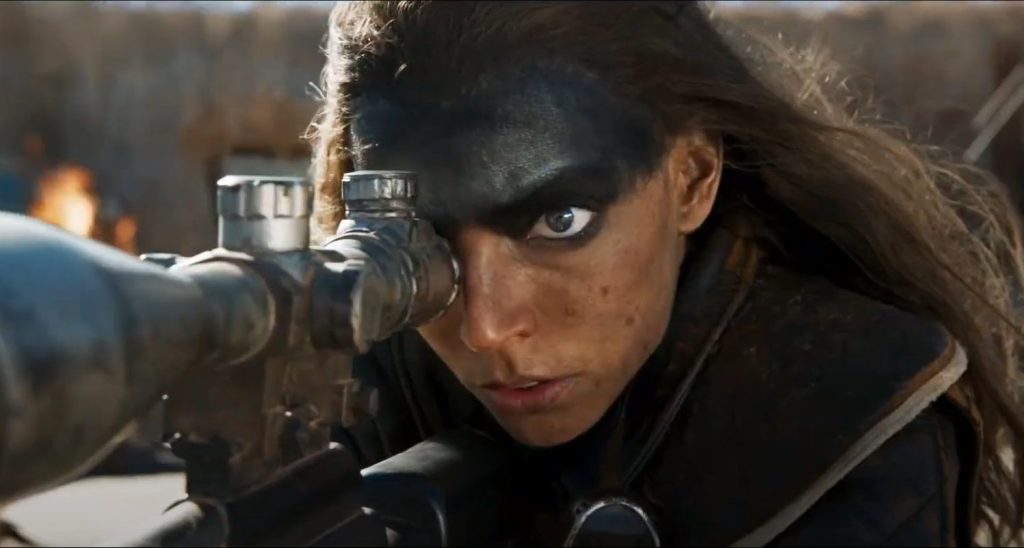Hollywood took a massive L this weekend thanks to the poor performance of George Miller’s Furiosa: A Mad Max Saga, a prequel to his acclaimed 2015 action masterpiece Fury Road. Analysts had the Anya Taylor-Joy/Chris Hemsworth vehicle smashing its way to an $80 million-plus worldwide debut. Instead, like Furiosa and Praetorian Jack evading Dementus, the pic crashed and burned with just over $60M. Ouch.
So, what led to this unexpected outcome? Several factors could have contributed to Furiosa’s underperformance. These include sequel fatigue, the film’s R-rated dark and gritty content, and the absence of A-list star power. However, the most straightforward explanation could be that the film didn’t cater to a market demand or need.
Simply put, no one asked for more Furiosa.
Chapter Doof
Full disclosure: I love Furiosa: A Mad Max Saga. I saw it three times over the weekend. I dig Miller’s maniacal style and Tom Holkenberg’s score, and I enjoy exploring new areas of the fabled Wasteland. For me, Mad Max is like the weird stepbrother to Star Wars, a vast world full of awesome heroes, terrifying villains, and endless possibilities.
As a child, I vividly remember watching The Road Warrior and being captivated by its unique landscapes. It presented a world teetering on the edge of madness, where car enthusiasts battled fiercely for control over essential resources like water and gasoline. In this chaotic environment, viewers are like guests observing the insanity without passing judgment. While details like the economics of locales such as Bartertown or the intricate rules of law and order might be lost on us, they make perfect sense to the rabble fighting for survival in the Wasteland, and that’s all that matters.
Mad Max eventually rode off into the sunset following a trilogy of films. Miller went on to other projects like The Witches of Eastwick, Babe: Pig in the City, Happy Feet, and Happy Feet 2. Then, in the late 90s, he turned his attention back to Mad Max and spent the better part of a decade crafting the franchise’s next chapter. (This is chronicled in the book Blood, Sweat & Chrome: The Wild and True Story of Mad Max, a terrific read if you have the time.)
Finally, in 2015, Mad Max: Fury Road blasted into cinemas like a War Boy covered in chrome, screaming “Witness me!” and instantly achieved classic status. Miller intensified the madness, presenting familiar chaos in a fresh and invigorating way. His Wasteland, gleaming with a new sheen, felt not like an old relic from the 1980s but the apex of action filmmaking. Critics showered Fury Road with awards, including ten Oscar nominations, and awarded it six. Everyone knows it was the best film of 2015 (if not the last decade), and I firmly believe Miller deserved to drive away with the Best Director award.
Naturally, it made sense for Miller to return to the Wasteland for more wild tales. Fury Road wasn’t an enormous hit, grossing just under $400M worldwide, but the film had hopefully piqued audience interest and, at the very least, set the stage for future adventures with Tom Hardy’s Max Rockatansky.
Instead, we got Furiosa: A Mad Max Saga, which has nothing to do with Max, aside from a brief cameo (and jettisons Charlize Theron in favor of Anya Taylor-Joy).
The New Road Warrior
Again, as stated, I adore Furiosa: A Mad Max Saga. The action, spectacle, performances, and storytelling are all on point. However, even I will admit that the film doesn’t propel the franchise in a nifty new direction. Instead, Miller spends two and a half hours reinforcing ideas he explored in Fury Road. We may understand Furiosa more than ever and view her mission in Fury Road in a more profound way. Yet, her origin story is not essential to the Mad Max saga and even feels a tad derivative.
A franchise like Mad Max satisfies by offering something original and unique with each chapter, rather than making U-turns into familiarity. Fury Road already provided ample insight into Immortan Joe, the Citadel, the War Pups, and more. Furiosa: A Mad Max Saga delves deeper into the intricacies of this corner of the Wasteland and sprinkles a few fun details, but falls short of quenching our thirst for novelty. Essentially, it’s an exceptionally well-made, entertaining DLC to the main quest of Fury Road, entertaining for some (like me) and frustrating for others.
After viewing Furiosa, a friend and fellow Max devotee explained, “All I want is a Mel Gibson Mad Max sequel. If I can’t get that, give me a Tom Hardy sequel.” Keep in mind that he enjoyed Furiosa immensely. He just wants more Max.
Therein lies the bleak truth. No offense to Charlize Theron’s dazzling Furiosa, but all eyes were on Tom Hardy following Fury Road — a film that curiously features Max more as a passenger than a driver. Where would Max head to next? Who else would he meet on his travels? Would he ever find peace, happiness, or love?
Oddly, Miller has plans for more Max, albeit in another prequel. I think that’s also a mistake. Again, we need to move forward, not backward. Future stories offer exciting possibilities, new characters, locations, and action. Another prequel inevitably ends with Fury Road. Where’s the fun in that?
Perhaps Miller is afraid that he can’t top Fury Road. Producing a film set in the past allows him to build toward the main event, while a sequel carries hefty expectations. At age 79, the acclaimed director might believe he achieved his ultimate masterpiece and will now spend his remaining days reaffirming its greatness to all.
Granted, Miller has earned the autonomy to shape this world as he sees fit. However, he must acknowledge the constraints of his franchise and the desires of his loyal fan base. If they crave Max, then Max is what they should receive. It’s that simple.
A Left Turn for Mad Max
A darker view of Furiosa’s failed box office is that general audiences are no longer interested in this franchise—or maybe they never were. (There’s also a question of whether it released too close to Dune: Part II, another dystopian fantasy set in the desert.)
Furiosa: A Mad Max Saga, with a $168M budget, needlessly pushes the franchise into billion-dollar or bust blockbuster territory where it doesn’t belong. Apart from the 1979 original, which grossed $99.7 million (according to The Numbers), the subsequent Mad Max films failed to spark significant box office success. The Road Warrior raked in $23 million worldwide (or $36 million, depending on the source), and Beyond Thunderdome brought in $36 million. These pictures catered to dudes seeking adrenaline-fueled carnage and were never designed to appeal to a broader audience.
Fury Road, despite its vast accolades and overwhelming critical success, failed to top Terminator Genisys at the worldwide box office. Hell, it barely surpassed The Good Dinosaur, often considered an enormous flop. The point is that Mad Max caters to a very specific crowd, a male-driven crowd that wants more Max. I imagine WB and Miller thought they could appeal to female audiences with Furiosa, perhaps expanding the franchise’s scope. Alas, women didn’t show up during the pic’s opening weekend. Per Deadline, men represented 72% of the audience.
So, what’s the lesson? If your franchise appeals to a specific crowd, give that specific crowd what they crave. In hindsight, WB should’ve handed Miller $75M and told him to make a Fury Road sequel with Tom Hardy (and possibly Mel Gibson as the villain). That picture may not have achieved Marvel-like success, either, but at least longtime fans would be happy.
As is, Furiosa: A Mad Max Saga doesn’t really please anyone but action junkies like me. Ironically, after achieving the ultimate victory, Furiosa still wound up stuck in the wasteland.










